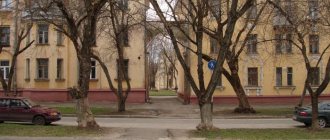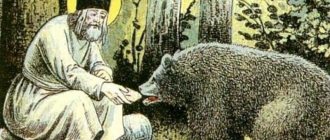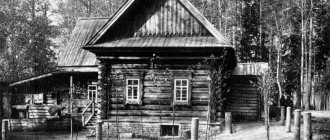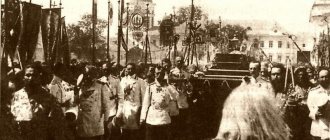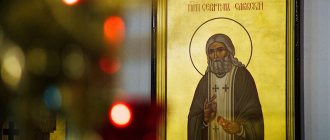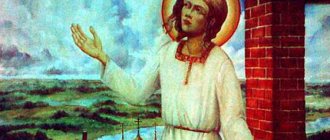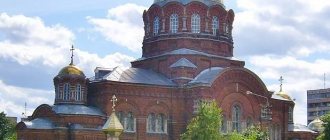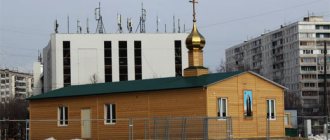| St. Seraphim of Sarov, icon of the beginning. XX century |
Seraphim of Sarov
(1754 - 1833), reverend, great ascetic of the Russian Church Memory January 2 - repose and second discovery of relics in 1991, July 19 - discovery of relics in 1903, in the Cathedrals of Kursk, Nizhny Novgorod, Tambov and Diveyevo saints
In the world Prokhor Isidorovich Moshnin, born July 19, 1754 [1]. The saint's parents, Isidore and Agathia, were residents of Kursk. Isidore was a merchant and took out contracts for the construction of buildings, and at the end of his life he began the construction of a cathedral in Kursk, but died before the completion of the work. The youngest son Prokhor remained in the care of his mother, who raised a deep faith in her son.
After the death of her husband, Agafia Moshnina, who continued the construction of the cathedral, once took Prokhor with her there, who, having stumbled, fell from the bell tower. The Lord saved the life of the future lamp of the Church: the frightened mother, going downstairs, found her son unharmed.
Young Prokhor, having an excellent memory, soon learned to read and write. Since childhood, he loved to attend church services and read the Holy Scriptures and Lives of Saints to his peers, but most of all he loved to pray or read the Holy Gospel in solitude.
One day Prokhor became seriously ill and his life was in danger. In a dream, the boy saw the Mother of God, who promised to visit and heal him. Soon a religious procession with the icon of the Sign of the Most Holy Theotokos passed through the courtyard of the Moshnin estate; his mother carried Prokhor out in her arms, and he venerated the holy icon, after which he began to quickly recover.
Even in his youth, Prokhor made the decision to completely devote his life to God and enter a monastery. The pious mother did not interfere with this and blessed him on the monastic path with a crucifix, which the monk wore on his chest all his life. Prokhor and the pilgrims set off on foot from Kursk to Kyiv to worship the Pechersk saints.
The schemamonk elder Dosifei, whom Prokhor visited, blessed him to go to the Sarov hermitage and save himself there. Returning briefly to his parents' house, Prokhor said goodbye to his mother and relatives forever.
Novice of the Sarov Desert
On November 20, 1778, he came to Sarov, where the wise old man, Father Pachomius, was then rector. He kindly received the young man and appointed Elder Joseph as his confessor. Under his leadership, Prokhor underwent many obediences in the monastery: he was the elder’s cell attendant, worked in the bakery, prosphora and carpentry shop, carried out the duties of a sexton, and performed everything with zeal and zeal, serving as if the Lord Himself. By constant work he protected himself from boredom - this, as he later said, “the most dangerous temptation for new monks, which is cured by prayer, abstinence from idle talk, feasible handicraft, reading the Word of God and patience, because it is born from cowardice, carelessness and idle talk.” .
Already in these years, Prokhor, following the example of other monks who retired into the forest to pray, asked the elder’s blessing to also go into the forest in his free time, where he prayed the Jesus Prayer in complete solitude.
Two years later, novice Prokhor fell ill with dropsy, his body became swollen, and he experienced severe suffering. The mentor, Father Joseph, and other elders who loved Prokhor looked after him. The illness lasted about three years, and not once did anyone hear a word of grumbling from him. The elders, fearing for the life of the patient, wanted to call a doctor to him, but Prokhor asked not to do this, telling Father Pachomius: “I have given myself, Holy Father, to the True Doctor of souls and bodies - our Lord Jesus Christ and His Most Pure Mother...”, and wanted to be given Holy Communion. Then Prokhor had a vision: the Mother of God appeared in an indescribable light, accompanied by the holy apostles Peter and John the Theologian. Pointing her hand at the sick man, the Most Holy Virgin said to John: “This one is from our generation.” Then she touched the patient’s side with the staff, and immediately the liquid that filled the body began to flow out through the hole formed, and he quickly recovered. Soon, on the site of the appearance of the Mother of God, a hospital church was built, one of the chapels of which was consecrated in the name of the Monks Zosima and Savvaty of Solovetsky. The altar for the chapel was built by the Monk Seraphim with his own hands from cypress wood and he always received the Holy Mysteries in this church.
Monk
On August 18, 1786, having spent eight years as a novice at the Sarov monastery, Prokhor took monastic vows with the name Seraphim, which so well expressed his fiery love for the Lord and desire to serve Him zealously.
A year later, in December 1787, Seraphim was ordained to the rank of hierodeacon. Burning in spirit, he served in the temple every day, constantly praying even after the service. The Lord vouchsafed the monk visions of grace during church services: he repeatedly saw holy angels serving with the brethren. The monk was granted a special vision of grace during the Divine Liturgy on Maundy Thursday, which was performed by the rector, Father Pachomius, and Elder Joseph. When, after the troparions, the monk said, “Lord, save the pious,” and, standing at the royal doors, pointed his orar at those praying with the exclamation “and forever and ever,” suddenly a bright ray overshadowed him. Raising his eyes, the Monk Seraphim saw the Lord Jesus Christ walking through the air from the western doors of the temple, surrounded by the Heavenly Ethereal Forces. Having reached the pulpit, the Lord blessed all those praying and entered the local image to the right of the royal doors. The Monk Seraphim, looking in spiritual delight at the wondrous phenomenon, could not utter a word or leave his place. He was led arm in arm into the altar, where he stood for another three hours, his face changing from the great grace that illuminated him. After the vision, the monk intensified his exploits: during the day he worked in the monastery, and spent his nights in prayer in a deserted forest cell.
Hieromonk
In 1793, at the age of 39, St. Seraphim was ordained to the rank of hieromonk and continued serving in the church.
Hermitage
After the death of the abbot, Father Pachomius, the Monk Seraphim, having his dying blessing for a new feat of desert living, also took the blessing from the new abbot - Father Isaiah I - and went to a desert cell a few kilometers from the monastery, in a dense forest. Here he began to indulge in solitary prayers, coming to the monastery only on Saturday, before the all-night vigil, and returning to his cell after the liturgy, during which he received communion of the Holy Mysteries.
The monk spent his life in severe exploits. He carried out his cell prayer rule according to the rules of the ancient desert monasteries; I never parted with the Holy Gospel, reading the entire New Testament during the week, and also read patristic and liturgical books. The monk learned many church hymns by heart and sang them during his work hours in the forest. Near the cell he planted a vegetable garden and built a beekeeper. Earning food for himself, the monk kept a very strict fast, eating once a day, and on Wednesday and Friday he completely abstained from food. In the first week of Holy Pentecost, he did not take food until Saturday, when he received Holy Communion. The holy elder, in solitude, was sometimes so immersed in inner heartfelt prayer that he remained motionless for a long time, neither hearing nor seeing anything around him. The hermits who visited him from time to time - schemamonk Mark the Silent and hierodeacon Alexander, having caught the saint in such prayer, quietly withdrew with reverence, so as not to disturb his contemplation.
In the summer heat, the monk collected moss from the swamp to fertilize the garden; mosquitoes mercilessly stung him, but he complacently endured this suffering, saying: “Pasions are destroyed by suffering and sorrow, either voluntary or sent by Providence.” For about three years the monk ate only one herb, snitis, which grew around his cell. In addition to the brethren, lay people began to come to him more and more often for advice and blessings. This violated his privacy. Having asked for the abbot’s blessing, the monk blocked women’s access to him, and then everyone else, having received a sign that the Lord approved of his idea of complete silence. Through the saint’s prayer, the road to his deserted cell was blocked by huge branches of centuries-old pine trees. Now only birds, which flocked in large numbers to the saint, and wild animals visited him. The monk fed the bear bread from his hands when bread was brought to him from the monastery.
Standing on a rock
Seeing the exploits of the Monk Seraphim, the enemy of the human race armed himself against him and, wanting to force the saint to leave silence, decided to frighten him, but the saint protected himself with prayer and the power of the Life-giving Cross. The devil brought “mental warfare” upon the saint—a persistent, prolonged temptation. To repel the onslaught of the enemy, the Monk Seraphim intensified his labors by taking upon himself the feat of stylite mongering. Every night he climbed a huge stone in the forest and prayed with raised hands, crying: “God, be merciful to me a sinner.” During the day, he prayed in his cell, also on a stone that he brought from the forest, leaving it only for a short rest and strengthening his body with meager food. The saint prayed like this for 1000 days and nights.
Beaten by robbers
The devil, disgraced by the monk, planned to kill him and sent robbers. Approaching the saint, who was working in the garden, the robbers began to demand money from him. The monk at that time had an ax in his hands, he was physically strong and could have defended himself, but he did not want to do this, remembering the words of the Lord: “Those who take the sword will perish by the sword” (Matthew 26:52). The saint, lowering the ax to the ground, said: “Do what you need.” The robbers began to beat the monk, broke his head with a butt, broke several ribs, then, having tied him up, they wanted to throw him into the river, but first they searched his cell in search of money. Having destroyed everything in the cell and finding nothing in it except an icon and a few potatoes, they were ashamed of their crime and left. The monk, having regained consciousness, crawled to his cell and, suffering severely, lay there all night.
The next morning, with great difficulty, he reached the monastery. The brethren were horrified when they saw the wounded ascetic. The monk lay there for eight days, suffering from his wounds; Doctors were called to him, surprised that Seraphim remained alive after such beatings. But the monk did not receive healing from doctors: the Queen of Heaven appeared to him in a subtle dream with the apostles Peter and John. Touching the head of the monk, the Most Holy Virgin granted him healing.
After this incident, the Monk Seraphim had to spend about five months in the monastery, and then he again went to a desert cell. Remaining bent forever, the monk walked, leaning on a staff or an axe, but he forgave his offenders and asked them not to punish them.
The feat of silence
After the death of the rector, Father Isaiah, who had been his friend since the saint’s youth, he took upon himself the feat of silence, completely renouncing all worldly thoughts for the purest stand before God in unceasing prayer.
If the saint met a person in the forest, he fell on his face and did not get up until the passerby moved away. The elder spent about three years in such silence, stopping even from visiting the monastery on Sundays. The fruit of silence was for St. Seraphim the acquisition of peace of soul and joy in the Holy Spirit. The great ascetic subsequently spoke to one of the monks of the monastery: “...my joy, I pray you, acquire a peaceful spirit, and then thousands of souls will be saved around you.”
Return to the monastery. Gate
The new abbot, Father Nifont, and the elder brethren of the monastery suggested that Father Seraphim either continue to come to the monastery on Sundays to participate in divine services and receive communion at the monastery of the Holy Mysteries, or return to the monastery. The monk chose the latter, since it became difficult for him to walk from the desert to the monastery. In the spring of 1810, he returned to the monastery after 15 years in the desert.
Without breaking his silence, he added seclusion to this feat and, without going anywhere or receiving anyone, he was constantly in prayer and contemplation of God. While in retreat, the Monk Seraphim acquired high spiritual purity and was granted special grace-filled gifts from God - clairvoyance and miracle-working. Then the Lord appointed His chosen one to serve people in the highest monastic feat - eldership.
Eldership
| Seraphim of Sarov |
On November 25, 1825, the Mother of God, together with the two saints celebrated on this day, appeared in a dream vision to the elder and commanded him to come out of seclusion and receive weak human souls that required instruction, consolation, guidance and healing.
Having been blessed by the abbot for a change in his lifestyle, the monk opened the doors of his cell to everyone. The elder saw the hearts of people, and he, as a spiritual doctor, healed mental and physical illnesses with prayer to God and a word of grace. Those who came to St. Seraphim felt his great love and listened with tenderness to the affectionate words with which he addressed people: “my joy, my treasure.” The elder began to visit his desert cell and the spring called Bogoslovsky, near which they built a small cell for him.
When leaving his cell, the elder always carried a knapsack with stones over his shoulders. When asked why he was doing this, the saint humbly answered: “I torment him who torments me.”
In the last period of his earthly life, the Monk Seraphim took special care of his beloved brainchild - the Diveyevo women's monastery. While still in the rank of hierodeacon, he accompanied the late rector Father Pachomius to the Diveyevo community to see the abbess nun Alexandra (Melgunova), a great ascetic, and then Father Pachomius blessed the reverend to always take care of the “Diveyevo orphans.” He was a true father for the sisters, who turned to him in all their spiritual and everyday difficulties. Disciples and spiritual friends helped the saint to care for the Diveyevo community - Mikhail Vasilyevich Manturov, who was healed by the monk from a serious illness and, on the advice of the elder, took upon himself the feat of voluntary poverty; Elena (Manturova), one of the Diveyevo sisters, who voluntarily agreed to die out of obedience to the elder for her brother, who was still needed in this life; Nikolai Alexandrovich Motovilov, also healed by the monk. ON THE. Motovilov recorded the wonderful teaching of St. Seraphim about the purpose of Christian life. In the last years of the life of the Monk Seraphim, one healed by him saw him standing in the air during prayer. The saint strictly forbade talking about this before his death.
Everyone knew and revered St. Seraphim as a great ascetic and wonderworker. A year and ten months before his death, on the Feast of the Annunciation, the Monk Seraphim was once again honored with the appearance of the Queen of Heaven, accompanied by the Baptist of the Lord John, the Apostle John the Theologian and twelve virgins, holy martyrs and saints. The Most Holy Virgin talked for a long time with the monk, entrusting the Diveyevo sisters to him. Having finished the conversation, She told him: “Soon, My beloved, you will be with us.” At this appearance, during the wondrous visit of the Mother of God, one Diveyevo old woman was present, through the prayer of the monk for her.
In the last year of his life, the Monk Seraphim began to noticeably weaken and spoke to many about his imminent death. At this time, he was often seen at the coffin, which stood in the entryway of his cell and which he had prepared for himself. The monk himself indicated the place where he should be buried - near the altar of the Assumption Cathedral.
Shortly before the blessed death of St. Seraphim, one pious monk asked him: “Why don’t we have such a strict life as the ancient ascetics led?” “Because,” answered the elder, “we do not have the determination to do so. If we had the determination, we would live like our fathers, because the grace and help of the faithful and those who seek the Lord with all their hearts is now the same as it was before, for, according to the word of God, the Lord Jesus Christ is the same yesterday and today and forever” (Heb. 13, 8).
On January 1, 1833, the Monk Seraphim came for the last time to the hospital Zosimo-Savvatievskaya Church for the liturgy and took communion of the Holy Mysteries, after which he blessed the brethren and said goodbye, saying: “Save yourself, do not be discouraged, stay awake, today crowns are being prepared for us.” On January 2, 1833, the monk’s cell attendant, Father Pavel, left his cell at six o’clock in the morning, heading to church, and smelled a burning smell coming from the monk’s cell; Candles were always burning in the saint’s cell, and he said: “As long as I am alive, there will be no fire, but when I die, my death will be revealed by fire.” When the doors were opened, it turned out that books and other things were smoldering, and the monk himself was kneeling before the icon of the Mother of God in a position of prayer, but already lifeless.
| The destruction of the Sarov monastery and the theft of the relics of St. Seraphim of Sarov. 14th stamp of the icon of the Council of New Martyrs and Confessors of Russia from the Cathedral of Christ the Savior. |
Relics and veneration
Through the prayers of St. Seraphim, numerous signs and healings were performed at his grave.
On July 19, 1903, the glorification of the saint of God took place. In the same year, a temple in the name of St. Seraphim was consecrated in the Sarov monastery. According to other sources, the first temple in the name of St. Seraphim in 1904 became the lower altar of the cathedral church of the Pochaev Holy Spiritual Skete [2].
On November 17, 1920, during the campaign to “open and liquidate the relics,” by decision of the IX Congress of Soviets of the city of Temnikov, the commission opened the shrine containing the relics of St. Seraphim. The relics of the saint rested in the Sarov monastery until its destruction in 1927, when they were taken to an unknown destination.
In 1991, the relics of the saint were rediscovered in Leningrad (now St. Petersburg) in the Museum of the History of Religion (Kazan Cathedral). In the same year they were transferred to Diveevo and since then have been in the Holy Trinity Seraphim-Diveevo Monastery.
| Cancer with the relics of St. Seraphim of Sarov, Diveevo. |
PRAYER STONE OF REVEREND SERAPHIM
Many pious traditions and legends are associated with stones in the popular consciousness. A special place here is occupied by the prayer stone of St. Seraphim of Sarov - a witness to the desert exploits of the elder, his incessant prayer. The Monk Seraphim departed to the Lord on the night of January 2, 1833 in the Sarov Hermitage. After his death, the things that belonged to him, according to a long-established custom, first went to the so-called ruin, and then were distributed among the elder’s admirers. The portrait of the monk was taken by the desert monk Gabriel, who “treasured it so much that he did not want to show it to anyone.” Two jugs—in which the ascetic carried water—were sent to the Teplov gentlemen in Taganrog. Seraphim’s hatchet remained with one of the sisters of the Diveyevo community, Paraskeva Ivanovna. The community was given two duckweeds of her spiritual father and hair that twice “fell out like felt from his head after his two painful sufferings.” One of the duckweeds was subsequently begged by a certain Mrs. Maria Kolycheva, and the hair was kept by the Diveyevo churchwoman Ksenia Vasilievna and the Sarov elder Father Theodosius. All these details are reported in the “Chronicle of the Seraphim-Diveevo Monastery,” compiled by Archimandrite, later Metropolitan Seraphim (Chichagov), now canonized. The Chronicle states that “the stones on which the elder went up to pray for a thousand days to kill the temptations of the enemy were transferred to the Diveyevo community. The one on which he stood during the day in his cell is in its previous form in the Church of the Transfiguration in Diveevo. From another of these stones, on which Fr. Seraphim prayed at night in front of the open sky; only one fragment remained, because pious visitors to Sarov, examining the places where Fr. Seraphim struggled, and units were constantly repulsed from him and taken away with them. And this remnant, about an arshin in diameter, was also transported to Diveevo soon after the death of the elder and placed in the same Transfiguration Church.” In place of the mentioned “remnant” in 1890, they put a boulder similar to the Seraphim, with two depressions, as if worn out by knees. But it was not destined to survive the revolutionary storms, and since July 1991, the third stone has been lying on the road from Sarov to Protyazhka. When Sarov, having become the closed city of Arzamas-16, became inaccessible to pilgrims, the people spontaneously transferred the veneration of the local relic to the Big and Small Bear stones in the forests near the village of Lesozavod. Strictly speaking, it was not the stones themselves that were revered, but the memory of St. Seraphim. Here it is appropriate to remember that in the pre-revolutionary years, images of a kneeling ascetic were carved out on small boulders, intended for pilgrims visiting the Sarov Hermitage and the Seraphim-Diveevo Monastery. The image of the Sarov elder praying on a stone became popular long before his canonization. The famous spiritual writer Evgeniy Nikolaevich Poselyanin, in an article published in 1903 “On the issue of images of St. Seraphim of Sarov,” wrote: “The image of Fr. Seraphim, it seems, is the most common - praying on a stone. Among the dark green thicket of the forest, he stands on a rock with his head open, dressed in a white robe, with a copper cross <...> with his hands raised to the sky. Near the stone on the ground, his hatchet and a bag of breadcrumbs are often depicted. This image of the elder is perhaps the most beloved by the elder’s admirers. In a large form - life-size - for example, in the chapel over the grave of the elder or in the chapel over the Seraphim spring, the image of the elder praying on a stone has an irresistible effect on the soul.” At the end, the author concludes: “Praying on a stone, full of meaning and poetry, must certainly become the content of the icons of the elder.” Already the first biographers of the saint described with special feeling how in the fall of 1794 he retired from the Sarov Hermitage to the Far Hermitage, where he indulged in prolonged prayer on a huge boulder. Saint Seraphim (Chichagov) explains the departure of the ascetic by the fact that, “seeing the humility of Elder Seraphim, the devil raised a great persecution against him, raised a mental battle in his soul.” Finding himself “in a difficult mental situation,” Father Seraphim did not succumb to fear, but still preferred to retire and on a granite stone cried out in a “publican’s voice”: “God, be merciful to me a sinner.” “He carried out this kind of prayerful feat at times for a thousand days,” emphasizes the “Chronicle”, the author of which wants to define Seraphim’s act precisely as pillar service. The monk spoke about this deed only at the end of his life and only to some of the brethren - for edification. When one of the listeners remarked in bewilderment about the impossibility of such a long prayer on a stone for human strength, the elder replied: “Saint Simeon the Stylite stood on the pillar for forty-seven years, but are my labors similar to his feat?” In the Orthodox East, two pillars named Simeon are revered. The eldest of them (September 1), who labored in Syrian Antioch, spent about 80 years in prayer on the pillar and died in 459, having passed the age of one hundred. However, the Monk Simeon the Younger of Divnogorsk (May 24), who accomplished his feat in the vicinity of Antioch on a pillar 140 cubits high, gained great fame. He died, according to some sources, in 596, according to others - in 592. Apparently, it was Simeon the Younger that St. Seraphim had in mind. There are so many similarities in the iconography of both pillars that sometimes their images are almost indistinguishable. On a silver plate dating back to the 6th-7th centuries, found in Syria and now kept in the Louvre, it is indicated that it was created “in thanksgiving to God and St. Simeon,” but it is impossible to determine which one - the Elder or the Younger. The stylite is represented standing with an open book inside a low enclosure at the top of a column entwined with a giant serpent; A multi-step staircase leads to the column. The head of Simeon, called a saint in the inscription, is nevertheless not yet surrounded by a halo, as we later see on medallions for pilgrims. The evolution of the iconography of St. Simeon of Divnogorets can be quite clearly traced in Georgian frescoes and stone reliefs of the 11th-13th centuries. What is especially remarkable is that in Western Georgia, stone pillars in the form of turrets (pirgi), erected in the 5th-6th and 11th-12th centuries, are still preserved. And in Martvili, a certain stylite labored in the first half of the 19th century, being a contemporary of St. Seraphim. In Rus', pillarism did not become widespread. Ancient Rus' knows only two stylites, and both lived in the 12th century. Saint Cyril of Turov, before his elevation to the rank of archpastor, was a monk in the Turov Boriso-Gleb Monastery, where, not content with the life of ordinary monks, he was the first of the Russians to asceticize on the pillar. The Monk Nikita of Pereslavl was in charge of collecting taxes in his hometown of Pereslavl-Zalessky and, darkened by the demon of greed, he firmly oppressed the weak and poor. But one day, a reading from the book of Isaiah the Prophet, heard in church, shocked him so much that he could not sleep all night. In the morning, Nikita thought of shaking himself up and invited his friends to a feast, but when his wife began to prepare dinner, she saw blood in a vessel with water, and then a dismembered human body. “Woe to me, who have sinned a lot,” said Nikita and, leaving his home forever, asked, for the sake of saving his soul, to go to the Nikitsky Monastery. In this monastery he shut himself up on a pillar, praying in chains and a stone cap for his sins. The people felt the strength of the pillars and responded vividly to their exploits. Back in the 18th century, in the Nikitsky monastery one could see how pilgrims, walking around the pillar of Nikita, put on his chains and a stone cap to better identify themselves with him. Simeon the Elder and Simeon the Divnogorets were depicted in Novgorod on the so-called tablets - small icons painted on tightly woven canvas. The frescoes of the Novgorod Church of the Transfiguration, painted by Theophan the Greek in 1378, also depict stylites. On an icon dated 1465 from the Anthony Dymsky Monastery (near Tikhvin), the Monk Simeon of Divnogorets is represented on a pillar with an arched opening, to which a three-step staircase leads; a basket and a jug are lowered from the pillar on ropes. Particular interest in pillarism arose in the Russian North at the end of the 15th century. Evidence of this is the inclusion of images of stylites in the iconostases, which had expanded versions of the Deesis order, and the appearance of hagiographic icons of St. Simeon the Divnogorets: in the second half of the 16th century, the icon of this saint became a temple icon in the Church of Simeon the Stylite in Veliky Ustyug. Having a good knowledge of the patristic works and hagiographic literature, the Monk Seraphim of Sarov, of course, strove to imitate the ancient stylites, but not in form alone, but first of all in essence, using and improving their spiritual experience. His own spiritual experience is an exceptional phenomenon, even if one does not agree with the statement of Hieromonk John (Kologrivov), expressed by him in “Essays on the History of Russian Holiness” that “this feat of pillar-bearing, carried out in the 19th century, is the only one of its kind.” History knows many cases when a stone became a monument to the establishment of Christianity. One of them is still the so-called Jellingen Stone, erected by King Harald Bluetooth, who was baptized in 960. In memory of this event, the king ordered to depict the crucified Christ on one side of the monolith in the shape of an irregular pyramid, and to make an inscription along the perimeter: “King Harald ordered this stone to be placed after his father Gorm and his mother Tira. He subjugated all of Denmark and Norway and baptized the Danes.” More recently, in Belarus, within the ancient Principality of Polotsk, one could see several huge boulders with images of crosses and inscriptions containing mention of a certain Boris, which gave rise to calling them Borisovs. It is now generally accepted that they had cult significance for the former pagan population, and the cross and inscriptions on them appeared around 1128 in connection with the Christianization of the region. In this sense, despite the physical destruction, the prayer stone of St. Seraphim of Sarov is still intact and “alive” - primarily in people’s memory.
Prayers
Troparion for repose, tone 4
From your youth you loved Christ, O blessed one,/ and you ardently desired the work of Him alone,/ you labored with unceasing prayer and labor in the desert,/ with a tender heart the love of Christ Having acquired this,/ the chosen one, beloved of God, appeared to the Mother./ For this reason we cry out to you:/ / Save us with your prayers, Seraphim, like our Father.
Troparion for glorification, same voice
From your youth you loved Christ, O Lord, / and you ardently desired to serve Him alone, / in your desert life you strived with unceasing prayer and labor, / with tenderness With your heart you have acquired the love of Christ, / Companion of heavenly Seraphim in hymn, / in love flowing to you to Christ imitator, / also the chosen one, beloved of God, you appeared to Mother, / for this reason we cry out to you: / save us with your prayers, our joy, / warm intercessor before God, / / Blessed Seraphim enne.
Kontakion, tone 2
Having left the beauty of the world and the corruption in it, O monk, / you moved into the Sarov monastery / and, having lived there like an angel, / you were the path to salvation for many, / for this sake, Christ is yours , Father Seraphim, glorify / and enrich with the gift of healings and miracles ./ Moreover we cry to you: Rejoice, Seraphim, like our Father.
Part 5. The exploits of Father Seraphim
Presenter. Soon the Monk Seraphim took upon himself a new feat: the feat of silence. Even later, he went into seclusion. Only 15 years later, St. Seraphim opened the doors of his cell to visitors, and at the same time accepted the feat of eldership - the spiritual care of the people.
Third girl. “Living water” poured from the lips of Elder Seraphim. Hundreds, thousands, tens of thousands of people from different parts of Russia began to come with their sorrows for spiritual advice to the bent old man.
First girl. Some with a request to pray for him, some for spiritual advice, some with mental pain, and some with some other sorrow. And he lovingly greeted each and every one with the words: “My joy.”
Choir (singing). To all those exhausted in the fire of the test, “My joy! - he repeats, - do not mourn, Spiritual storms, thunderstorms, suffering, for the sake of the Lord, endure with a smile!
Used materials
- Russian Orthodoxy
website page : - “The communal Sarov Hermitage and the memorable monks who labored in it” M.: Sretensky Monastery, 1996, 241 p. pp. 64, 85, 91.
- Monthly page of the Journal of the Moscow Patriarchate
- Venerable Seraphim of Sarov // Page of the site “ABC of Faith”
- Menaion-July, part 2, ed. Moscow Patriarchate, p. 36-37, 44:
- and - troparia
- - kontakion
[1] There is a widespread erroneous version of the birth date of Seraphim of Sarov - in 1759. And even this date was carved on the saint’s gravestone. However, numerous documents testify in favor of the 54th year of birth. Mass media
[2] Serpeninov Valentin, “The Holy Spirit Skete of the Pochaev Lavra: the historical path,” official website of the Department of Church History of the Moscow Theological Academy, May 26, 2015,
Part 2. What do we live for?
Presenter. From time to time God raises up His great saints, who, according to His holy will, serve the salvation of the world with their whole lives.
First girl. What do we live for? Young Prokhor Moshnin is increasingly interested in this question. The soul yearns for God, seeks God's work.
Second girl. He decides to go to the monastery, and his mother blesses him with a large copper cross, which he always wore on his chest over his clothes.
Third girl. Prokhor served as a novice for eight years and zealously carried out his obedience. His soul became more and more perfected. First boy
And the Angel said to him: “Go, leave their cities, hide in the desert, so that there the fire of the lamp, entrusted to you, may be preserved until its time; So that, like the poverty of vanities, they will thirst for truth and desire light, They would have something to light their lamps with.” (A. Maikov)
First girl. Father Seraphim built a cell in the forest to retire. He spent days and nights in strict fasting and prayer.
Third boy Far from people, In silence and prayer, In fasting and silence, this Elder lived. Dark demons were scorched in a fiery battle with prayer, cross and humility.
Hieromonk Seraphim, lithograph from 1862
Helps people quench their spiritual thirst
As you know, Father Seraphim regularly reread the Holy Scriptures, especially the New Testament, quoted it by heart and instructed everyone to reread it. He said that the Holy Scripture is the primary source with which, first of all, one must compare one’s life.
“At that time it was not customary to read the Scriptures on their own; rather, the laity were even warned against such reading. Therefore, the advice of St. Seraphim to his contemporaries could seem quite revolutionary. For these spiritual principles he had to endure much oppression and persecution. Often even the monks in his monastery did not share the views of Seraphim of Sarov. So his life was quite difficult, and it was not easy for him to defend his views.
The most important thing is that he helped people find an answer to that spiritual thirst that often arises in a person in an indefinite form, when he is looking for something, but this search does not take on a specific form, embodiment, or expression in life. And St. Seraphim always tried to give people the opportunity to quench this spiritual thirst, embody and express it in real events in their lives,” says Kirill Mozgov.
photo: shutterstock.com
The relics of St. Seraphim are kept in the Nizhny Novgorod region, in the Diveyevo convent. In the last period of the saint’s earthly life, this monastery became his favorite child, he took great care of it. Nowadays, many people come there to venerate the incorruptible remains of the holy ascetic. And an even larger number of believers pray to Seraphim of Sarov and ask him for help. They say that the priest always gives practical advice, and people understand that this was an answer from him, even if this answer comes many days and weeks after the prayer.
Biography of Seraphim of Sarov
Seraphim of Sarov (Prokhor Isidorovich Mashnin, in a number of sources - Moshnin) is a great Russian ascetic, miracle worker, man of prayer, who performed many good deeds, miracles and ascetic deeds: standing on a stone for a thousand days, silence, desert living, seclusion, old age.
Seraphim of Sarov
He is one of the two most revered monastic saints in Russia who, during canonization, received the face of a god-like figure, that is, a saint (along with Sergius of Radonezh).
